#florian sievers
Explore tagged Tumblr posts
Text
Musik Podium Stuttgart - "Der Heilands letzte Stunden" di Louis Spohr
Foto ©Mozart2006 Analogamente a quanto accadde per figure letterarie come ad esempio quella del suo contemporaneo Friedrich Rückert, anche Louis Spohr Continue reading Untitled

View On WordPress
#arttu kataja#canto#critica#deutsche kammerphilharmonie bremen#felix rathgeber#florian sievers#frieder bernius#johanna winkel#kammerchor stuttgart#liederhalle#louis spohr#maximilian vogler#musik podium stuttgart#sinfonica#strumentale#stuttgart#thomas e. bauer
1 note
·
View note
Text
The Galician campaign of 1809
Today let me tell you a little bit about the Galician campaign of the Austro-Polish war of 1809, which proved to be a great success for the Duchy of Warsaw.
After the battle of Raszyn there happened the series of small battles, which prevented Austrians from crossing the Vistula, thus leaving the initiative on the right bank of the river firmly with the Poles. So, the Polish forces under Poniatowski’s command moved along Vistula to the South-East, to the lands Austria seized during the latest partition of Poland.
On the 14th of May the Polish Army entered Lublin:
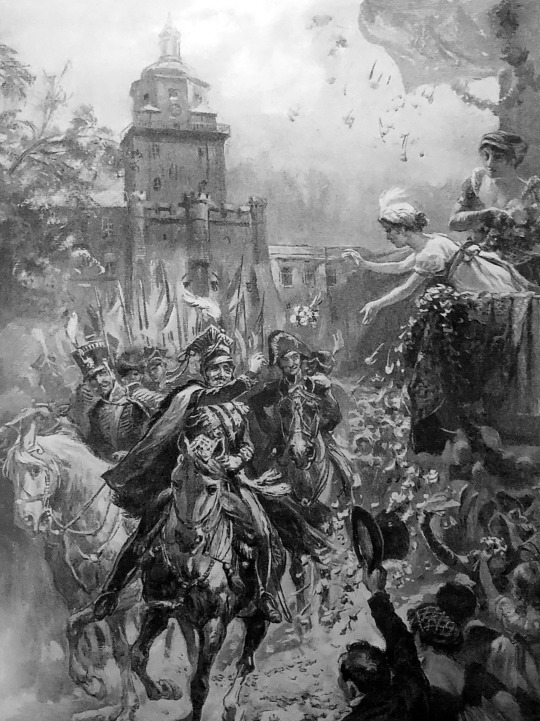
Konstanty Gorski, "Prince Józef Poniatowski enters conquered Lublin in 1809, showered with flowers by ladies"
As Kajetan Koźmian recalls in his memoirs, Poniatowski and his men were greeted with "joy and elation", and in the evening "... the city and the citizens gave a great ball <...> in the house in Korce. Prince Józef honored them with his presence starting the ball."
The next city on the way of the Polish Army was Sandomierz, and after a short siege it was taken on the 18th of May.

Siege of Sandomierz in 1809.
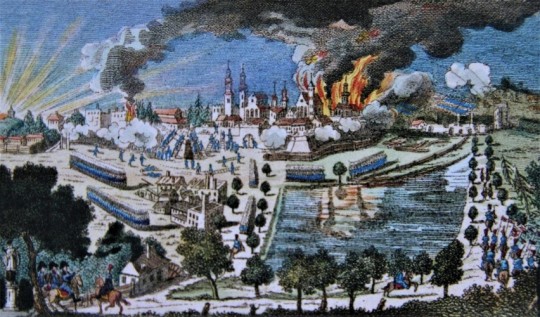
Michał Stachowicz, a scene from the battles in Galicia ("The Capture of Zamość")
Then there was Zamość, where the Polish trooped entered on the 20th of May.
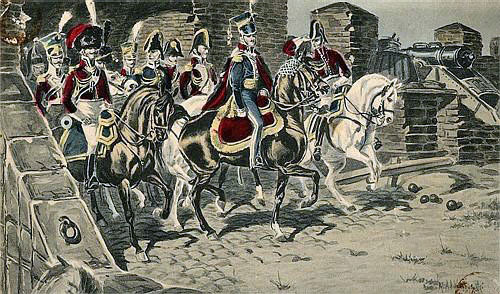
Siege of 1809, M. Adamczewski Entry of Prince Poniatowski to Zamość (postcard)
On the 27th of May the Polish advanced forces even reached the city of Lwów, but prince Józef wasn’t among them.
Meanwhile the Austrians under command Archduke Ferdinand realized the precariousness of their position in the center of Poland, and on the 1st of June left Warsaw for the south.
Poniatowski, for his part, decided not to engage with the Austrian, focusing instead on "liberating” as much Galician land as possible.
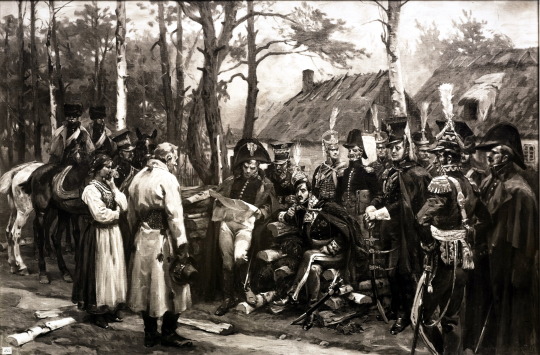
Prince Józef Poniatowski seeks information from local peasants in Galicia in 1809, a photo of Stanisław Bagieński's painting
On the 3rd June there appeared the third participant of the events - Russian forces crossed the Austrian border to Galicia as well. And though formally they were acting as Napoleon’s ally, as was prescribed in the Tilsit Treaty, their real goal was to prevent the Poles from taking too much of the Austrian-held territories.
So, to outwit the Russians prince Józef was taking Galician cities not in the name of the Duchy of Warsaw, but in the one of emperor of the Frenchmen. Like the proclamations were being made in the name of Napoleon, the eagles on the coats-of-arms replacing the Austrian ones were not Polish and French etc.
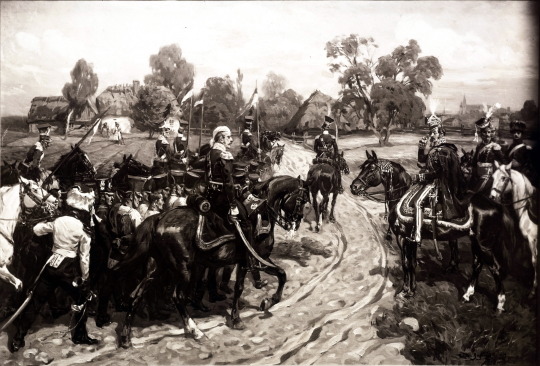
Lancers lead Austrian prisoners of war near Kraków in 1809, in front of Prince Józef Poniatowski, a photo of Stanisław Bagieński's painting
Then, in the outer theater of war on the 6th of July the French defeated the Austrians at the Battle of Wagram. And according Franco-Austrian truce signed five days later the land division was to take place along the line where the troops were at the time of receiving news of the truce, not at the time its signing.

The Austrian army leaves Wawel, a postcard based on the painting of Wojciech Kossak
And so began the race between Russians and Poles, to advance to as farther as possible.
In the middle of July both armies reached Kraków.

PRINCE JOSEPH'S ENTRY TO KRAKOW. A drawing by Jan Feliks Piwarski.
And there the clash of the interest took place.
Poniatowski approached the city from the side of St. Florian's Gate, but it turned out that the Austrians, wanting more comfortable terms of capitulation, had already let Russian troops into Kraków.
The Russians, namely the Cossacks of General Sievers, wanted to deny Poniatowski passage. But Prince Józef, as Dezydery Chłapowski recalls in his memoirs, "draw his broadsword and with together his staff galloped into the gate through the Cossacks". The Polish infantry followed its commander "in a double step <...> so that the Cossacks were pressed against the walls of the gate." Seeing this, Mariampol's hussar regiment, which was stationed at that time in the market square, make a decision to put up resistance and due to this, the whole Polish army was able to enter the city.

Michał Stachowicz, The entry of Prince Józef Poniatowski into Krakow on July 15, 1809
Then, as Ambroży Grabowski recalled, when prince Józef’s troops reached the market square, “in front of the church of St. Wojciech, the magistrate went out to meet the prince, to give him the keys of the city”.
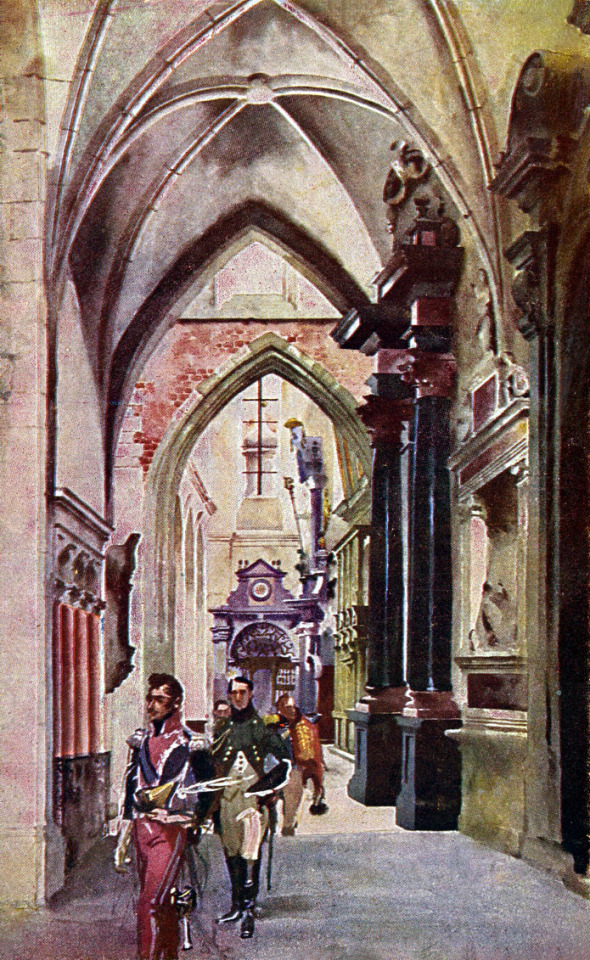
Józef Poniatowski in the Cathedral after Kraków was taken from the Austrians, an image by Stanisław Tondos and Wojciech Kossak
Most probably prince Józef visited the Wawel cathedral during his sojourn in Kraków that time. (In a small voice: little did he know that in 8 years he’ll be buried there...)
And after exactly a month since the Polish troops entered Kraków, there was a ball arranged in the Cloth-hall, the image depicting it I have already posted here.
#Poniatowski#Jozef Poniatowski#józef poniatowski#1809#Galicia#Lublin#Sandomierz#Zamość#Kraków#Austro-Polish War#Konstanty Gorski#Michał Stachowicz#Stanisław Bagieński#Wojciech Kossak#Feliks Piwarski#Kajetan Koźmian#Dezydery Chłapowski#ambroży grabowski
34 notes
·
View notes
Text
QUARTONAL
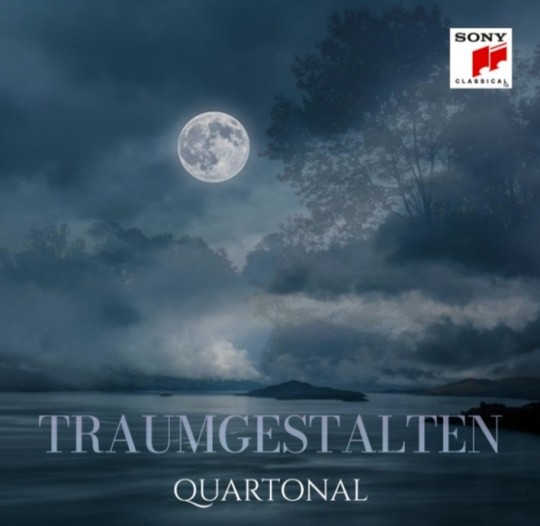
TRAUMGESTALTEN
"Traumgestalten" - canciones románticas a capella con el renombrado conjunto vocal Quartonal en Sony Classical.
Consíguelo AQUÍ
Cuatro hombres, cuatro voces, un sonido: Quartonal es uno de los conjuntos vocales más solicitados de Alemania desde hace más de 15 años. Y el repertorio de los cuatro cantantes del norte de Alemania abarca desde canciones corales clásicas y folclóricas hasta canciones pop y folclóricas internacionales. Para su tercer álbum para Sony Classical, Quartonal ha seleccionado canciones románticas y romanticistas de los siglos XIX y XX bajo el título "Traumgestalten". Se trata de poemas de Goethe, Heine, Eichendorff y Mörike, entre otros. Las canciones y baladas son de compositores tan importantes como Felix Mendelssohn Bartholdy y Hugo Wolf. También hay canciones populares, algunas en arreglos modernos.
Temáticamente, las 15 canciones de "Traumgestalten" giran en torno a temas como el amor, el placer y la naturaleza. Felix Mendelssohn, por ejemplo, adaptó "Wasserfahrt" de Heinrich Heine a una pieza coral melancólica y al mismo tiempo oscilante. Wenzel Heinrich Veit (1806-1864) envolvió la famosa balada de Goethe "El rey en Thule" en una canción folclórica. Mathieu Neumann (1867-1928), por su parte, transformó el "Feuerreiter" de Eduard Mörike en una historia de terror musical.
SOBRE EL ARTISTA
El conjunto a capella Quartonal se fundó en 2006 y es uno de los grupos vocales más prometedores surgidos en Alemania en los últimos años. En 2010, los cuatro cantantes (Mirko Ludwig - tenor, Florian Sievers - tenor, Christoph Behm - barítono y Sönke Tams Freier - bajo) de Hamburgo ofrecieron una sensacional actuación de debut en el Concurso Nacional de Coros de Alemania, obteniendo el primer puesto en la categoría de Conjunto Vocal. Impulsados por su éxito en el concurso, Quartonal se embarcó inmediatamente en una apretada agenda de conciertos nacionales e internacionales. El álbum debut de Quartonal, "Another Way - English Vocal Music", se publicó en 2013 en colaboración con Sony Music. Su lanzamiento fue aclamado por la crítica y recibió elogiosas críticas.
Tras su éxito en el Concurso Nacional de Coros de Alemania, Quartonal cosechó una serie de aplausos en concursos de toda Europa. En 2012, Quartonal recibió los premios del público y del jurado en el concurso "A cappella" de Leipzig (Alemania) y en el concurso coral "Tolosako Abesbatza Lehiaketa" de Tolosa (España).
Las canciones también incluyen temas populares como "Ein Jäger längs dem Weiher ging" y "Die Gedanken sind frei" en nuevos arreglos. Entre las rarezas se encuentra una balada escrita por el compositor de origen polaco Joseph Kromolicki (1882-1961) sobre un texto de Justinus Kerner. Y los "Schilflieder" del compositor suizo Heinrich Sutermeister ponen de relieve cómo los compositores del siglo XX cultivaron el tono romántico. Cuesta creer que se compusieran en 1968.
La grabación fue una coproducción de SWR Kultur y Sony Classical.
"Traumgestalten" de Quartonal saldrá a la venta el 8 de diciembre a través de Sony Classical en CD y digitalmente.
0 notes
Text
youtube
Max Reger (1873-1916) - 5 Choralkantaten, WoO V/4: Nr. 3, O Haupt voll Blut und Wunden
Artist: Marie Henriette Reinhold
Artist: Florian Sievers
Artist: Gundel Jannemann-Fischer
Artist: Dietrich Reinhold Choir: GewandhausChor
Artist: Michael Schönheit Conductor: Gregor Meyer
1 note
·
View note
Text
Johann Sebastian Bach Matthäus-Passion BWV 244
Live übertragen am 05.04.2023 aus der Elbphilharmonie Hamburg
Freiburger Barockorchester Vox Luminis Hamburger Knabenchor Zsuzsi Tóth | Sopran Gwendoline Blondeel | Sopran Alexander Chance | Alt William Shelton | Countertenor Raphael Höhn | Evangelist Florian Sievers | Tenor Raffaele Giordani | Tenor Sebastian Myrus | Jesus Felix Schwandtke | Bass Lionel Meunier | Leitung
0 notes
Photo










Ten Cities
Clubbing in Nairobi, Cairo, Kyiv, Johannesburg, Naples, Berlin, Luanda, Lagos, Bristol, Lisbon,. 1960-March 2020
With essay by: Rui Miguel Abreu, Vitalii Bard Bardetski, Vítor Belanciano, Tony Benjamin, Danilo Capasso, Vincenzo Cavallo, Iain Chambers, Kateryna Dysa, Johannes Ebert, Maha ElNabawi, Michelle Henning, Rangoato Hlasane, Johannes Hossfeld Etyang, Rehan Hyder, Mukami Kuria, Ângela Mingas, Ali Abdel Mohsen, Marissa J. Moorman, Joyce Nyairo, Sean O’Toole, Sellanga Ochieng’ Blinky Bill, Bill Odidi, Tobias Rapp, Florian Sievers, Peter Wafula Wekesa, Mallam Mudi Yahaya. Edited by Johannes Hossfeld Etyang, Joyce Nyairo, Florian Sievers.
With photographs by Anita Baumann, Beezer, Royce Bett, Tilman Brembs, Giovanni Calemma, Martin Eberle, Mosa'ab Elshamy, Nina Fischer & Maroan el Sani, Max Fonseca, Kiluanji Kia Henda, Andreas Langfeld, Lucio Luongo, Musa N. Nxumalo, Eva Maria Ocherbauer, Chris Saunders, Jürgen Schadeberg, Gavin Watson, Tobias Zielony, a.o.
Spector Books, Leipzig 2020, 560 pages, paperback, with ca. 47 black-white and ca. 115 colour images, 20x27cm, ISBN 9783944669793
euro 49,50
email if you want to buy :[email protected]
A project by Goethe-Institut
Ten Cities tells the story of club music and club cultures in ten urban centres across Africa and Europe from 1960 to March 2020. It looks beyond the North Atlantic locations that are usually assumed to be the main focus of attention and sets out to put together a more inclusive narrative. Bringing clubs to the fore as nocturnal laboratories for different ways of life, the book portrays the cities’ music subcultures in twenty-one essays, playlists, and photo sequences – before COVID-19 impacted creative communities worldwide. It is a retrospective testimony to their living spirit, a rhythmanalysis mediated by sound and night.
16/04/21
orders to: [email protected]
ordini a: [email protected]
twitter: @fashionbooksmi
instagram: fashionbooksmilano, designbooksmilano tumblr: fashionbooksmilano, designbooksmilano
#ten cities#clubbing#Nairobi#Cairo#Kyiv#Johannesburg#Napoli#Berlin#Luanda Lagos#Bristol#Lisbon#club music#club cultures#music subcultures#massive attack#fashionbooksmilano
41 notes
·
View notes
Text
Tip for the Weekend: Malzwiese Festival, 2.-3. June 2018, Berlin
youtube
Malzwiese is more than just another music festival in Berlin. For a few years it brings not only a great selection of artists but also workshops, theater, lectures, food a lovely little lake and much more. There’ll be Circus Kadarka - a slightly different kind of circus, an anit-circus as they call it. And Siegfried and Joy, a magical duo. Literally. During artnight you can follow the motto “everyone can paint” and create your own painting with some professional help. You prefer photography? No problem at Malzwiese. They have an old school plate camera and a dark room so you’ll have you photo in just a few minutes. Or you take a look at the exhibition of Nils Lucas who has been traveling with bands for the last couple of years.
And then there is some decent live music as well. There’ll be Bonaparte’s trash punk, Die Höchste Eisenbahn will bring their Pop for grown ups, the audience will go crazy to the modern Rock of Razz, Leyya will lighten the evening with their Pop with a hint of melancholy... but trust me, don’t just show up late because there are some pretty fine artist playing in the afternoon, too. I look forward to see Das Paradies. German Pop by Florian Sievers who I have always loved in his other band Talking To Turtles. Or Unter meinem Bett (under my bed) which is music for kids but not the kitschy kind of dumb making music. They’ll make you dance, sing and think.
For more information about the Malzwiese festival go to their website:
www.malzwiese.de
Show up and dance with me!
Have a good day,
Dörte
1 note
·
View note
Photo

Das Paradies And Keshavara - Sine Wave - Neues Video Nachdem er gemeinsam mit Claudia Göhler als Talking To Turtles insgesamt drei Alben veröffentlicht hatte, präsentierte Florian Sievers alias Das Paradies im September 2017 mit „Goldene Zukunft“ seine erste Solo-Single, auf der er erstmals in seiner Muttersprache auf Deutsch singt. Die Debüt-Single kam in Begleitung des B-Side-Tracks „Du, Die Anderen Und Ich“, gefolgt von der dritten […] #DasParadies #Keshavara https://www.musikblog.de/2020/11/das-paradies-and-keshavara-sine-wave-neues-video/
0 notes